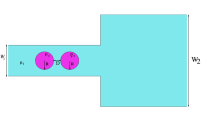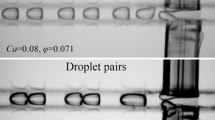Abstract
In the present paper, merging of two successive compound droplets in an abrupt expansion microchannel using direct numerical simulations is presented. The compound droplets undergo deformation and velocity decreases when entering the expansion region. Their interaction behaviors are divided into two modes of merging and non-merging. These two modes are dominated, and influenced by fluid dynamic parameters, compound droplets’ center distance, the expansion ratio of microchannels and the size of compound droplets, which are analyzed through the results of numerical simulation. The capillary number, the fluid viscosity, and the droplets’ distance increase lead to the merging time of the droplets increases. Although increasing the inner interfacial tension does not significantly affect the merging time of two outer droplets, it significantly reduces the merging time of two inner droplets. Meanwhile, varying the expansion ratio and the droplet size results in the transition between the two interaction modes. Two diagrams for the mode transition, based on the capillary number, the droplet center separation, and the droplet size are also given.













Similar content being viewed by others
Availability of Data and Materials
Data available on request from the authors.
References
Abate, A.R., Thiele, J., Weitz, D.A.: One-step formation of multiple emulsions in microfluidics. Lab Chip 11, 253–258 (2011). https://doi.org/10.1039/C0LC00236D
Abate, A.R., Weitz, D.A.: High-order multiple emulsions formed in poly(dimethylsiloxane) microfluidics. Small 5, 2030–2032 (2009). https://doi.org/10.1002/smll.200900569
Arias, S., González-Cinca, R.: Experimental analysis of the bubble–slug transition in a flow generated by a T-junction in a minichannel with air/water and air/ethanol mixtures in conditions relevant to microgravity. Chem. Eng. Sci. 91, 5–10 (2013). https://doi.org/10.1016/j.ces.2012.12.036
Borthakur, M., Biswas, G., Bandyopadhyay, D.: Dynamics of deformation and pinch-off of a migrating compound droplet in a tube. Phys. Rev. E 97 (2018). https://doi.org/10.1103/PhysRevE.97.043112
Bui, D.T., Vu, H.V., Nguyen, Q.D., Vu, T.V.: A multi-core compound droplet passing through a diffuser channel. J. Mech. Sci. Technol. 35, 5049–5060 (2021). https://doi.org/10.1007/s12206-021-1022-1
Capretto, L., Carugo, D., Mazzitelli, S., Nastruzzi, C., Zhang, X.: Microfluidic and lab-on-a-chip preparation routes for organic nanoparticles and vesicular systems for nanomedicine applications. Adv. Drug Delivery Rev. 65, 1496–1532 (2013). https://doi.org/10.1016/j.addr.2013.08.002
Chang, Y., Sheng, L., Wang, J., Deng, J., Luo, G.: A general neural network model co-driven by mechanism and data for the reliable design of gas–liquid T-junction microdevices. Lab Chip 23, 4888–4900 (2023). https://doi.org/10.1039/D3LC00355H
Chen, J., Vestergaard, M., Shen, J., Solem, C., Dufva, M., Jensen, P.: Droplet-based microfluidics as a future tool for strain improvement in lactic acid bacteria. FEMS Microbiol. Lett. 366, i10–i16 (2019). https://doi.org/10.1093/femsle/fny258s
Duncanson, W.J., Lin, T., Abate, A.R., Seiffert, S., Shah, R.K., Weitz, D.A.: Microfluidic synthesis of advanced microparticles for encapsulation and controlled release. Lab Chip 12, 2135–2145 (2012). https://doi.org/10.1039/C2LC21164E
Etminan, A., Muzychka, Y.S., Pope, K.: Numerical investigation of gas–liquid and liquid–liquid Taylor flow through a circular microchannel with a sudden expansion. Can. J. Chem. Eng. 100, 1596–1612 (2022). https://doi.org/10.1002/cjce.24229
Hayat, Z., El Abed, A.: High-throughput optofluidic acquisition of microdroplets in microfluidic systems. Micromachines 9 (2018). https://doi.org/10.3390/mi9040183
Hirt, C.W., Nichols, B.D.: Volume of fluid (VOF) method for the dynamics of free boundaries. J. Comput. Phys. 39, 201–225 (1981). https://doi.org/10.1016/0021-9991(81)90145-5
Ho, N.X., Vu, T.V.: Numerical simulation of the deformation and breakup of a two-core compound droplet in an axisymmetric T-junction channel. Int. J. Heat Fluid Flow 86, 108702 (2020). https://doi.org/10.1016/j.ijheatfluidflow.2020.108702
Hu, B., Xu, P., Ma, L., Chen, D., Wang, J., Dai, X., Huang, L., Du, W.: One cell at a time: droplet-based microbial cultivation, screening and sequencing. Mar. Life Sci. Technol. 3, 169–188 (2021). https://doi.org/10.1007/s42995-020-00082-8
Jeyhani, M., Thevakumaran, R., Abbasi, N., Hwang, D.K., Tsai, S.S.H.: Microfluidic generation of all-aqueous double and triple emulsions. Small 16, 1906565 (2020). https://doi.org/10.1002/smll.201906565
Kadivar, E., Heidary Zarneh, Z.: Droplet coalescence in a sudden expansion microchannel. Acta Mech. 233, 2201–2212 (2022). https://doi.org/10.1007/s00707-022-03220-8
Lam, S., Velikov, K.P., Velev, O.D.: Pickering stabilization of foams and emulsions with particles of biological origin. Curr. Opin. Colloid Interface Sci. 19, 490–500 (2014). https://doi.org/10.1016/j.cocis.2014.07.003
Li, J., Chen, H., Stone, H.A.: Breakup of double emulsion droplets in a tapered nozzle. Langmuir 27, 4324–4327 (2011). https://doi.org/10.1021/la200473h
Lu, P., Zhao, L., Zheng, N., Liu, S., Li, X., Zhou, X., Yan, J.: Progress and prospect of flow phenomena and simulation on two-phase separation in branching T-junctions: A review. Renew. Sustain. Energy Rev. 167, 112742 (2022). https://doi.org/10.1016/j.rser.2022.112742
Merdasi, A., Ebrahimi, S., Moosavi, A., Shafii, M.B., Kowsary, F.: Numerical simulation of collision between two droplets in the T-shaped microchannel with lattice Boltzmann method. AIP Adv. 6, 115307 (2016). https://doi.org/10.1063/1.4967361
Narsimhan, G., **ang, N.: Role of proteins on formation, drainage, and stability of liquid food foams. Annu. Rev. Food Sci. Technol. 9, 45–63 (2018). https://doi.org/10.1146/annurev-food-030216-030009
Nguyen, C.T., Vu, H.V., Vu, T.V., Truong, T.V., Ho, N.X., Pham, B.D., Nguyen, H.D., Nguyen, V.T.: Numerical analysis of deformation and breakup of a compound droplet in microchannels. Eur. J. Mech. B. Fluids 88, 135–147 (2021). https://doi.org/10.1016/j.euromechflu.2021.03.005
Nguyen, K.P., Vu, T.V.: Collision modes of two eccentric compound droplets. Processes 8, 602 (2020). https://doi.org/10.3390/pr8050602
Nguyen, V.T., Vu, T.V., Nguyen, P.H., Pham, B.D., Nguyen, H.D., Phan, H.T., Vu, H.V.: Marangoni motion of a droplet in a constriction. Microgravity Sci. Technol. 34, 32 (2022). https://doi.org/10.1007/s12217-022-09958-z
Nooranidoost, M., Kumar, R.: Improving viability of leukemia cells by tailoring shell fluid rheology in constricted microcapillary. Sci. Rep. 10, 11570 (2020). https://doi.org/10.1038/s41598-020-67739-3
Pan, K.-L., Law, C.K., Zhou, B.: Experimental and mechanistic description of merging and bouncing in head-on binary droplet collision. J. Appl. Phys. 103, 064901 (2008). https://doi.org/10.1063/1.2841055
Sattari, A., Hanafizadeh, P.: Controlled preparation of compound droplets in a double rectangular co-flowing microfluidic device. Colloids Surf. A Physicochem. Eng. Asp. 602, 125077 (2020). https://doi.org/10.1016/j.colsurfa.2020.125077
Schirrmann, K., Cáceres-Aravena, G., Juel, A.: Self-assembly of coated microdroplets at the sudden expansion of a microchannel. Microfluid. Nanofluid. 25, 29 (2021). https://doi.org/10.1007/s10404-021-02424-z
Shen, C., Chen, Y., Yu, C., Liu, X.: Numerical study on the liquid-liquid interface evolution during droplet coalescence. Microgravity Sci. Technol. 32, 737–748 (2020). https://doi.org/10.1007/s12217-020-09805-z
Sheng, L., Chang, Y., Wang, J., Deng, J., Luo, G.: Hydrodynamics of gas–liquid microfluidics: A review. Chem. Eng. Sci. 285, 119563 (2024). https://doi.org/10.1016/j.ces.2023.119563
Sussman, M., Fatemi, E., Smereka, P., Osher, S.: An improved level set method for incompressible two-phase flows. Comput. Fluids 27, 663–680 (1998). https://doi.org/10.1016/S0045-7930(97)00053-4
Tao, Y., Rotem, A., Zhang, H., Chang, C.B., Basu, A., Kolawole, A.O., Koehler, S.A., Ren, Y., Lin, J.S., Pipas, J.M., Feldman, A.B., Wobus, C.E., Weitz, D.A.: Rapid, targeted and culture-free viral infectivity assay in drop-based microfluidics. Lab Chip 15, 3934–3940 (2015). https://doi.org/10.1039/C5LC00556F
Ted, F., John, M.W.: The Savvy Separator: Physical processes behind oil droplet coalescence during water treatment. (2017). https://jpt.spe.org/savvy-separator-physical-processes-behind-oil-droplet-coalescence-during-water-treatment
Utada, A.S., Lorenceau, E., Link, D.R., Kaplan, P.D., Stone, H.A., Weitz, D.A.: Monodisperse double emulsions generated from a microcapillary device. Science 308, 537–541 (2005). https://doi.org/10.1126/science.1109164
Vakili, S., Steinbach, I., Varnik, F.: Multi-phase-field simulation of microstructure evolution in metallic foams. Sci. Rep. 10, 19987 (2020). https://doi.org/10.1038/s41598-020-76766-z
Viswanathan, H.: The effect of junction gutters for the upscaling of droplet generation in a microfluidic T-Junction. Microgravity Sci. Technol. 34, 43 (2022). https://doi.org/10.1007/s12217-022-09954-3
Vu, T.V.: Parametric study of the collision modes of compound droplets in simple shear flow. Int. J. Heat Fluid Flow 79, 108470 (2019). https://doi.org/10.1016/j.ijheatfluidflow.2019.108470
Vu, T.V., Bui, D.T., Nguyen, Q.D., Pham, P.H.: Numerical study of rheological behaviors of a compound droplet in a conical nozzle. Int. J. Heat Fluid Flow 85, 108655 (2020). https://doi.org/10.1016/j.ijheatfluidflow.2020.108655
Vu, T.V., Pham, P.H.: Numerical study of a compound droplet moving toward a rigid wall in an axisymmetric channel. Int. J. Heat Fluid Flow 82, 108542 (2020). https://doi.org/10.1016/j.ijheatfluidflow.2020.108542
Vu, T.V., Vu, L.V., Pham, B.D., Luu, Q.H.: Numerical investigation of dynamic behavior of a compound drop in shear flow. J. Mech. Sci. Technol. 32, 2111–2117 (2018). https://doi.org/10.1007/s12206-018-0420-5
Wang, J., Liu, J., Han, J., Guan, J.: Rheology investigation of the globule of multiple emulsions with complex internal structures through a boundary element method. Chem. Eng. Sci. 96, 87–97 (2013). https://doi.org/10.1016/j.ces.2013.02.065
Wang, T., Andersen, S.I., Shapiro, A.: Coalescence of oil droplets in microchannels under brine flow. Colloids Surf. A 598, 124864 (2020). https://doi.org/10.1016/j.colsurfa.2020.124864
Windbergs, M., Zhao, Y., Heyman, J., Weitz, D.A.: Biodegradable core-shell carriers for simultaneous encapsulation of synergistic actives. J. Am. Chem. Soc. 135, 7933–7937 (2013). https://doi.org/10.1021/ja401422r
Zeng, W., **ang, D., Fu, H.: Prediction of droplet production speed by measuring the droplet spacing fluctuations in a flow-focusing microdroplet generator. Micromachines. 10, 812 (2019). https://doi.org/10.3390/mi10120812
Funding
This research is funded by Vietnam National Foundation for Science and Technology Development (NAFOSTED) under grant No. 107.03-2023.48.
Author information
Authors and Affiliations
Contributions
N.X.H. and H.V.V. were responsible for visualization, investigation, and writing-original draft. T.V.V. was responsible for conceptualization, methodology, writing-reviewing and editing and supervision. All authors reviewed the manuscript.
Corresponding author
Ethics declarations
Ethics Approval
The authors confirm that the manuscript is original and has not been published elsewhere or is it currently under consideration for publication elsewhere.
Consent to Participate
Not applicable.
Consent for Publication
All authors provided the consent for publication.
Conflict of Interest
The authors declare no competing interests.
Additional information
Publisher's Note
Springer Nature remains neutral with regard to jurisdictional claims in published maps and institutional affiliations.
Rights and permissions
Springer Nature or its licensor (e.g. a society or other partner) holds exclusive rights to this article under a publishing agreement with the author(s) or other rightsholder(s); author self-archiving of the accepted manuscript version of this article is solely governed by the terms of such publishing agreement and applicable law.
About this article
Cite this article
Ho, N.X., Vu, H.V. & Vu, T.V. Collision Behaviors of Two Successive Compound Droplets in an Abrupt Expansion Microchannel. Microgravity Sci. Technol. 36, 6 (2024). https://doi.org/10.1007/s12217-023-10095-4
Received:
Accepted:
Published:
DOI: https://doi.org/10.1007/s12217-023-10095-4




